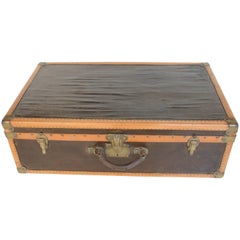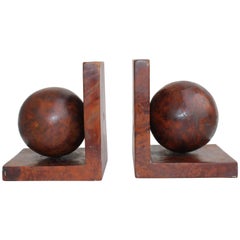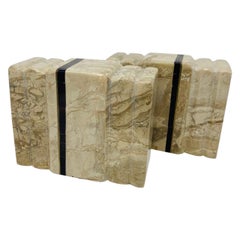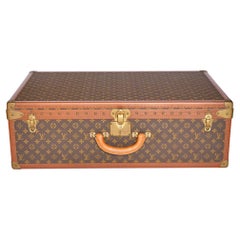Futuro Anteriore Home Accents
to
1
2
2
1
2
1
1
1
2
1
1
1
1
2
1
1
2
2
2
1
Louis Vuitton Early 20th Century Luggage Suitcase Brown Leather Brass Locks
By Louis Vuitton
Located in Sacile, PN
Suitcase by Louis Vuitton, dated 1910 circa. Engraved latch, brown and camel leather.
Category
Early 20th Century French Trunks and Luggage
Materials
Brass
$1,197 Sale Price
43% Off
Wooden Art Deco Bookends Spherical Round
Located in Sacile, PN
Art Deco bookends in wood.
Category
Vintage 1930s Italian Mid-Century Modern Bookends
Materials
Wood
$808 / set
Related Items
Vintage Art Deco Marble Bookends by Renoir
By Renoir Designs
Located in San Diego, CA
Beautiful pair of art deco marble bookends by Renoir. These sizeable pieces of marble are captivating as they are commanding. The veining that develops on the beige marble with pink ...
Category
Vintage 1950s American Art Deco Bookends
Materials
Marble
20th Century Louis Vuitton Suitcase Alzer 80, 1970
By Louis Vuitton
Located in Epfach, DE
909481 Alzer 80 80 cm x 26 cm 52.5 cm with removable tray
Louis Vuitton suitcase, Alzer 80 with removable tray, in wonderful, well-kept condition with origin...
Category
20th Century French Trunks and Luggage
Materials
Leather
French Art Deco Fishes Bookends, 1920
Located in Saint-Amans-des-Cots, FR
A pair of French Art Deco bookends, circa 1930, featuring two stylized fish designs. Crafted from a combination of spelter, glass, and marble, these bookends showcase the clean lines...
Category
Vintage 1920s French Art Deco Bookends
Materials
Marble, Spelter
Antique LOUIS VUITTON Leather Hardcase Suitcase – Early 20th Century
By Louis Vuitton
Located in Victoria, BC
A distinguished piece of travel history, this antique Louis Vuitton hardcase suitcase is a fine example of the craftsmanship that defined luxury travel in the early 20th century. Con...
Category
Early 20th Century French Trunks and Luggage
Materials
Leather
Art Deco Woman Sculpture Bookends, France, 1920s
Located in Buenos Aires, Olivos
Art Deco female figure - Sculpture bookends, France, 1920s.
Pair of female bookends in silver plated finish, great pose in the Art Deco style, made in France.
We have specialized in...
Category
Early 20th Century French Art Deco Figurative Sculptures
Materials
Metal
20th Century Louis Vuitton Suitcase In Monogram Canvas, France c.1970
By Louis Vuitton
Located in Royal Tunbridge Wells, Kent
A charming Louis Vuitton hard-sided case, mid to late 20th century, the exterior finished in the famous monogram canvas with brass fittings. A great piece for use today or as a decor...
Category
20th Century French Other Trunks and Luggage
Materials
Brass
$4,246
H 18.51 in W 27.56 in D 8.67 in
20th Century Louis Vuitton Suitcase Classic Monogram Canvas 60s
By Louis Vuitton
Located in Turin, Turin
Timeless suitcase by Louis Vuitton from the 60s with rounded edges and a double zipper. It is easy to carry with its comfortable rounded handles and bears a removable ID holder. It i...
Category
Vintage 1960s French Modern Trunks and Luggage
Materials
Leather
$4,753
H 13.78 in W 21.26 in D 7.49 in
1930s Art Deco Marble Bookends
Located in Tarrytown, NY
1930s Art Deco Marble Bookends
Green marble with white veining
Gold marble with black veining
This pair of bookends would look great in an office or recording studio
Evokes old Holl...
Category
Vintage 1930s Art Deco Bookends
Materials
Stone, Marble
Striking & Hand Carved, Stylized Wooden Art Deco Nude Female Sculpture Bookends
Located in Lisse, NL
Impressive and highly stylish female bookends, hand carved out nutwood.
The artist who handcarved these wonderfully stylized, sitting female bookends has perfectly captured the natu...
Category
Early 20th Century French Art Deco Bookends
Materials
Nutwood
$1,485 / set
H 6.8 in W 4.45 in D 3.1 in
French Art Deco Cat & Dog Bookends, 1920
Located in Saint-Amans-des-Cots, FR
These charming French Art Deco bookends, dating from the 1920s, feature a noble combination of woods and brass, showcasing the elegant craftsmanship of the era. The cat and dog figur...
Category
Vintage 1920s French Art Deco Bookends
Materials
Brass
Zadounaisky Pair of Art Deco Bookends
By Michel Zadounaïsky
Located in NANTES, FR
Pair of art deco bookends circa 1930.
Antelope model in wrought iron, copper and wood.
Stamped Zadouniasky.
In perfect condition.
Total height: 16 cm
Width: 8 cm
Length: 17.5 cm
Wei...
Category
Mid-20th Century French Art Deco Bookends
Materials
Copper, Wrought Iron
20th Century Louis Vuitton Suitcase In Monogram Canvas, France c.1970
By Louis Vuitton
Located in Royal Tunbridge Wells, Kent
A delightful mid to late 20th-century Louis Vuitton hard-sided case, covered with the iconic monogram canvas and complemented by brass fittings. The exterior exudes the unmistakable ...
Category
Vintage 1970s French Other Trunks and Luggage
Materials
Leather, Canvas
$5,207
H 6.7 in W 27.56 in D 18.9 in



